Critical Analysis of Cross-Sectional Study on HIV Patients (22NURSING)
VerifiedAdded on 2022/12/29
|27
|9027
|53
Report
AI Summary
This report provides a critical analysis of an analytical cross-sectional study in nursing research, focusing on the quality of life (QoL) of older adults living with HIV. The study utilizes the Joanna Briggs Institute (JBI) Critical Appraisal tool to evaluate the methodological specifications and credibility of the research. The report is structured into three sections: an introduction highlighting the importance of nursing research, a discussion on the significance of critical analysis and the JBI tool, and a detailed critical appraisal of the selected research article. The analysis examines the study's inclusion and exclusion criteria, sampling methods, and the reliability and validity of its findings, including confounding factors, outcome measurements, and statistical analyses. The goal is to understand how to improve nursing interventions and overall outcomes for older adults with HIV by analyzing their perspectives on QoL. The report also highlights the importance of evidence-based practice in nursing and the role of nurses in improving the QoL of patients. The study emphasizes the need for a deeper understanding of the sociological and mental health concerns of people living with HIV to develop effective, person-centered care guidelines and interventions.
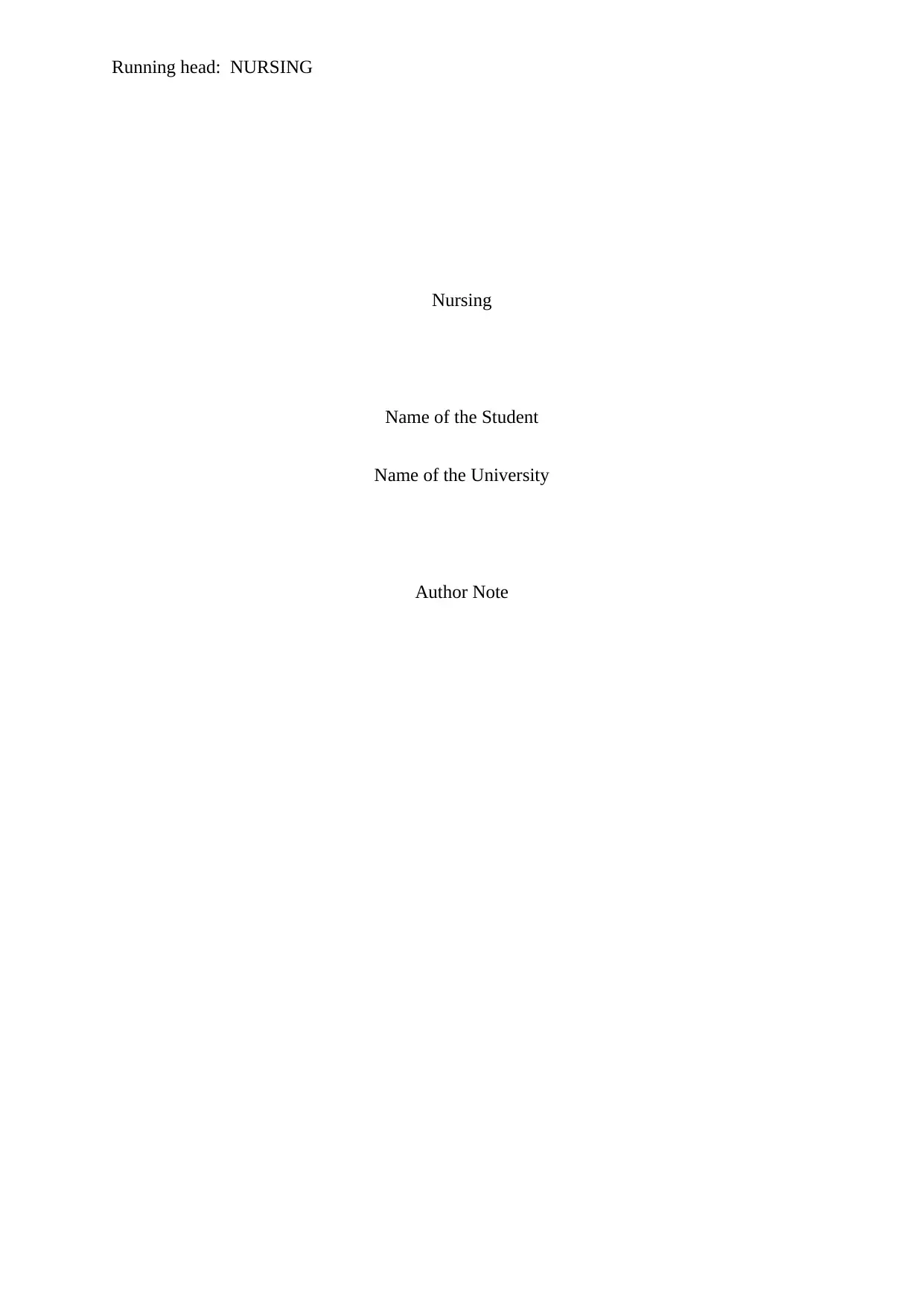
Running head: NURSING
Nursing
Name of the Student
Name of the University
Author Note
Nursing
Name of the Student
Name of the University
Author Note
Paraphrase This Document
Need a fresh take? Get an instant paraphrase of this document with our AI Paraphraser
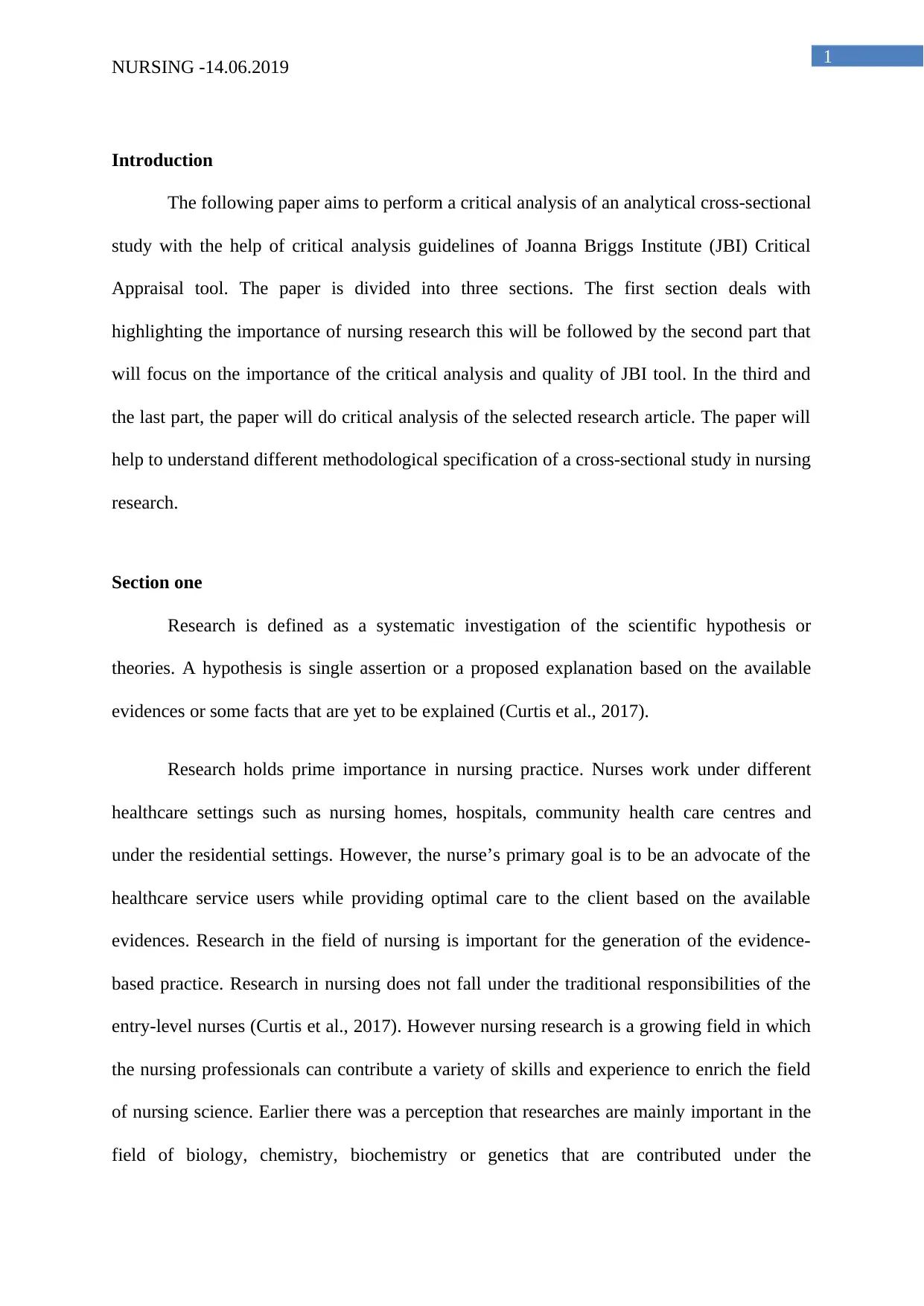
1
NURSING -14.06.2019
Introduction
The following paper aims to perform a critical analysis of an analytical cross-sectional
study with the help of critical analysis guidelines of Joanna Briggs Institute (JBI) Critical
Appraisal tool. The paper is divided into three sections. The first section deals with
highlighting the importance of nursing research this will be followed by the second part that
will focus on the importance of the critical analysis and quality of JBI tool. In the third and
the last part, the paper will do critical analysis of the selected research article. The paper will
help to understand different methodological specification of a cross-sectional study in nursing
research.
Section one
Research is defined as a systematic investigation of the scientific hypothesis or
theories. A hypothesis is single assertion or a proposed explanation based on the available
evidences or some facts that are yet to be explained (Curtis et al., 2017).
Research holds prime importance in nursing practice. Nurses work under different
healthcare settings such as nursing homes, hospitals, community health care centres and
under the residential settings. However, the nurse’s primary goal is to be an advocate of the
healthcare service users while providing optimal care to the client based on the available
evidences. Research in the field of nursing is important for the generation of the evidence-
based practice. Research in nursing does not fall under the traditional responsibilities of the
entry-level nurses (Curtis et al., 2017). However nursing research is a growing field in which
the nursing professionals can contribute a variety of skills and experience to enrich the field
of nursing science. Earlier there was a perception that researches are mainly important in the
field of biology, chemistry, biochemistry or genetics that are contributed under the
NURSING -14.06.2019
Introduction
The following paper aims to perform a critical analysis of an analytical cross-sectional
study with the help of critical analysis guidelines of Joanna Briggs Institute (JBI) Critical
Appraisal tool. The paper is divided into three sections. The first section deals with
highlighting the importance of nursing research this will be followed by the second part that
will focus on the importance of the critical analysis and quality of JBI tool. In the third and
the last part, the paper will do critical analysis of the selected research article. The paper will
help to understand different methodological specification of a cross-sectional study in nursing
research.
Section one
Research is defined as a systematic investigation of the scientific hypothesis or
theories. A hypothesis is single assertion or a proposed explanation based on the available
evidences or some facts that are yet to be explained (Curtis et al., 2017).
Research holds prime importance in nursing practice. Nurses work under different
healthcare settings such as nursing homes, hospitals, community health care centres and
under the residential settings. However, the nurse’s primary goal is to be an advocate of the
healthcare service users while providing optimal care to the client based on the available
evidences. Research in the field of nursing is important for the generation of the evidence-
based practice. Research in nursing does not fall under the traditional responsibilities of the
entry-level nurses (Curtis et al., 2017). However nursing research is a growing field in which
the nursing professionals can contribute a variety of skills and experience to enrich the field
of nursing science. Earlier there was a perception that researches are mainly important in the
field of biology, chemistry, biochemistry or genetics that are contributed under the
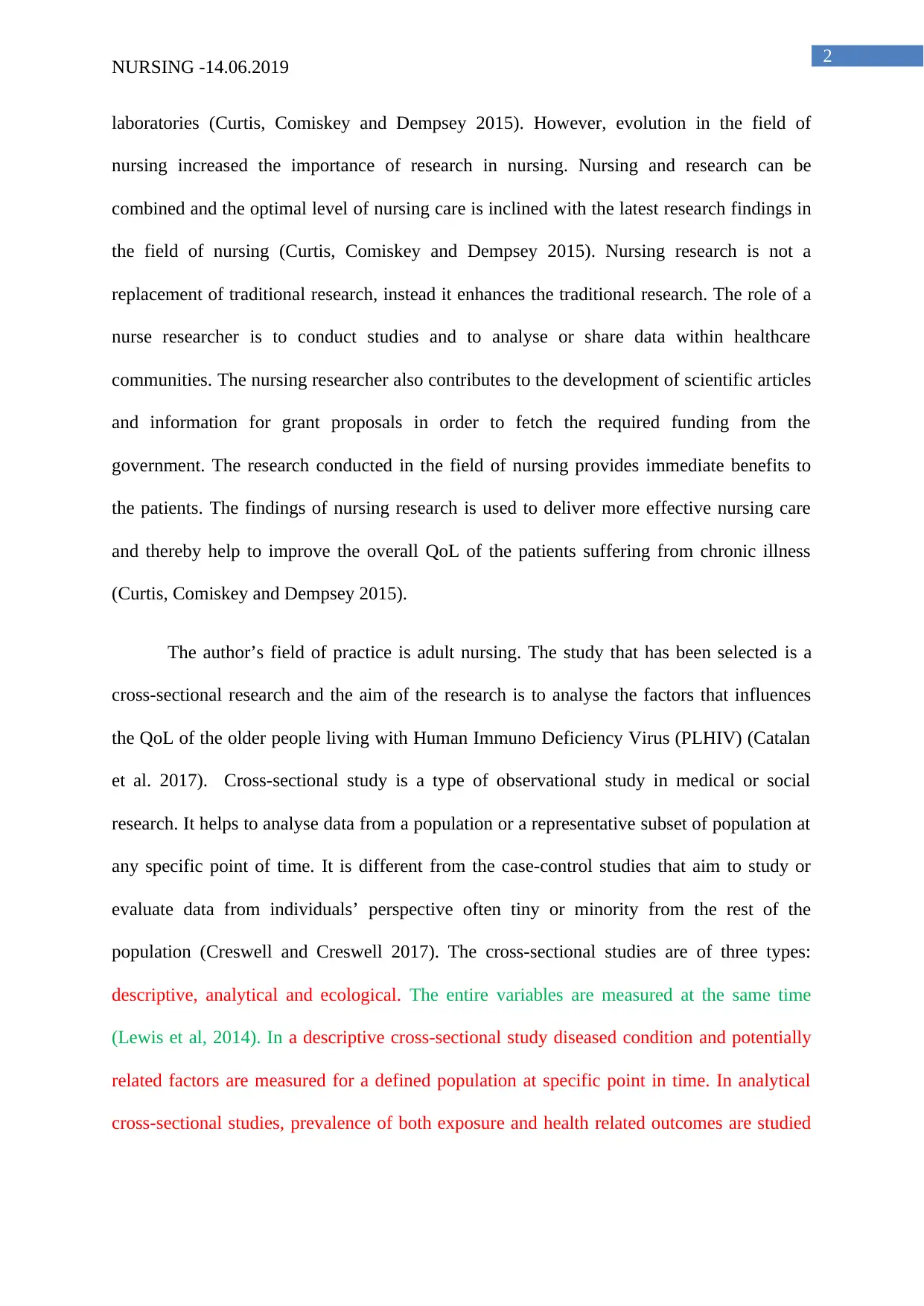
2
NURSING -14.06.2019
laboratories (Curtis, Comiskey and Dempsey 2015). However, evolution in the field of
nursing increased the importance of research in nursing. Nursing and research can be
combined and the optimal level of nursing care is inclined with the latest research findings in
the field of nursing (Curtis, Comiskey and Dempsey 2015). Nursing research is not a
replacement of traditional research, instead it enhances the traditional research. The role of a
nurse researcher is to conduct studies and to analyse or share data within healthcare
communities. The nursing researcher also contributes to the development of scientific articles
and information for grant proposals in order to fetch the required funding from the
government. The research conducted in the field of nursing provides immediate benefits to
the patients. The findings of nursing research is used to deliver more effective nursing care
and thereby help to improve the overall QoL of the patients suffering from chronic illness
(Curtis, Comiskey and Dempsey 2015).
The author’s field of practice is adult nursing. The study that has been selected is a
cross-sectional research and the aim of the research is to analyse the factors that influences
the QoL of the older people living with Human Immuno Deficiency Virus (PLHIV) (Catalan
et al. 2017). Cross-sectional study is a type of observational study in medical or social
research. It helps to analyse data from a population or a representative subset of population at
any specific point of time. It is different from the case-control studies that aim to study or
evaluate data from individuals’ perspective often tiny or minority from the rest of the
population (Creswell and Creswell 2017). The cross-sectional studies are of three types:
descriptive, analytical and ecological. The entire variables are measured at the same time
(Lewis et al, 2014). In a descriptive cross-sectional study diseased condition and potentially
related factors are measured for a defined population at specific point in time. In analytical
cross-sectional studies, prevalence of both exposure and health related outcomes are studied
NURSING -14.06.2019
laboratories (Curtis, Comiskey and Dempsey 2015). However, evolution in the field of
nursing increased the importance of research in nursing. Nursing and research can be
combined and the optimal level of nursing care is inclined with the latest research findings in
the field of nursing (Curtis, Comiskey and Dempsey 2015). Nursing research is not a
replacement of traditional research, instead it enhances the traditional research. The role of a
nurse researcher is to conduct studies and to analyse or share data within healthcare
communities. The nursing researcher also contributes to the development of scientific articles
and information for grant proposals in order to fetch the required funding from the
government. The research conducted in the field of nursing provides immediate benefits to
the patients. The findings of nursing research is used to deliver more effective nursing care
and thereby help to improve the overall QoL of the patients suffering from chronic illness
(Curtis, Comiskey and Dempsey 2015).
The author’s field of practice is adult nursing. The study that has been selected is a
cross-sectional research and the aim of the research is to analyse the factors that influences
the QoL of the older people living with Human Immuno Deficiency Virus (PLHIV) (Catalan
et al. 2017). Cross-sectional study is a type of observational study in medical or social
research. It helps to analyse data from a population or a representative subset of population at
any specific point of time. It is different from the case-control studies that aim to study or
evaluate data from individuals’ perspective often tiny or minority from the rest of the
population (Creswell and Creswell 2017). The cross-sectional studies are of three types:
descriptive, analytical and ecological. The entire variables are measured at the same time
(Lewis et al, 2014). In a descriptive cross-sectional study diseased condition and potentially
related factors are measured for a defined population at specific point in time. In analytical
cross-sectional studies, prevalence of both exposure and health related outcomes are studied
⊘ This is a preview!⊘
Do you want full access?
Subscribe today to unlock all pages.

Trusted by 1+ million students worldwide

3
NURSING -14.06.2019
for comparing differences between exposed and unexposed health outcomes. In ecological
cross-sectional studies the unit of observation is community
Catalan et al (2017 study is an analytical type of cross sectional study, hence using the
specified JBI analytical framework. A cross-sectional study helps to study some specific
feature of a population. For example, in medical science, cross-sectional study helps to study
the prevalence of illness or to support cause and effect relationship (Creswell and Creswell,
2017). The topic is selected because in United Kingdom (UK) more than 25,000 people who
are aged 50 years and above are living with HIV (Yin et al., 2014). Analyzing the perspective
of HIV patients in health related quality of life (HRQoL) will help to improve the process of
early implementation of the nursing interventions in addition to improving the overall
outcome of care of the older adults with HIV (Althoff et al., 2016). The selection of cross-
sectional study design will help to get perspective of QoL from the thought process of
communication. They used a grounded theory in collecting quantitative data. Grounded
theory is a systematic methodology used in research involved in construction of theories for
gathering of information. It does not follow any traditional model of research where authors
choose an existing model of research (Althoff et al., 2016). The authors here used
quantitative collection of research data to study the cause and effect relationships to help
establish the relationship between the dependent variable and independent variable. The
independent variable in the chosen research is HRQoL and dependent variables in the
research are factors that promote HRQoL.
Emlet et al. (2015) are of the opinion that PLHIV with access to antiretroviral (ARV)
treatments at present are growing older and living healthier lives in comparison to the HIV
survivors in mid 1990s. While the healthcare improvements along with an increase in the
survival rates are welcomed, the social and the psychological consequences of ageing and its
relation to the prognosis of HIV are complex (Emlet et al., 2015) Although the individual
NURSING -14.06.2019
for comparing differences between exposed and unexposed health outcomes. In ecological
cross-sectional studies the unit of observation is community
Catalan et al (2017 study is an analytical type of cross sectional study, hence using the
specified JBI analytical framework. A cross-sectional study helps to study some specific
feature of a population. For example, in medical science, cross-sectional study helps to study
the prevalence of illness or to support cause and effect relationship (Creswell and Creswell,
2017). The topic is selected because in United Kingdom (UK) more than 25,000 people who
are aged 50 years and above are living with HIV (Yin et al., 2014). Analyzing the perspective
of HIV patients in health related quality of life (HRQoL) will help to improve the process of
early implementation of the nursing interventions in addition to improving the overall
outcome of care of the older adults with HIV (Althoff et al., 2016). The selection of cross-
sectional study design will help to get perspective of QoL from the thought process of
communication. They used a grounded theory in collecting quantitative data. Grounded
theory is a systematic methodology used in research involved in construction of theories for
gathering of information. It does not follow any traditional model of research where authors
choose an existing model of research (Althoff et al., 2016). The authors here used
quantitative collection of research data to study the cause and effect relationships to help
establish the relationship between the dependent variable and independent variable. The
independent variable in the chosen research is HRQoL and dependent variables in the
research are factors that promote HRQoL.
Emlet et al. (2015) are of the opinion that PLHIV with access to antiretroviral (ARV)
treatments at present are growing older and living healthier lives in comparison to the HIV
survivors in mid 1990s. While the healthcare improvements along with an increase in the
survival rates are welcomed, the social and the psychological consequences of ageing and its
relation to the prognosis of HIV are complex (Emlet et al., 2015) Although the individual
Paraphrase This Document
Need a fresh take? Get an instant paraphrase of this document with our AI Paraphraser
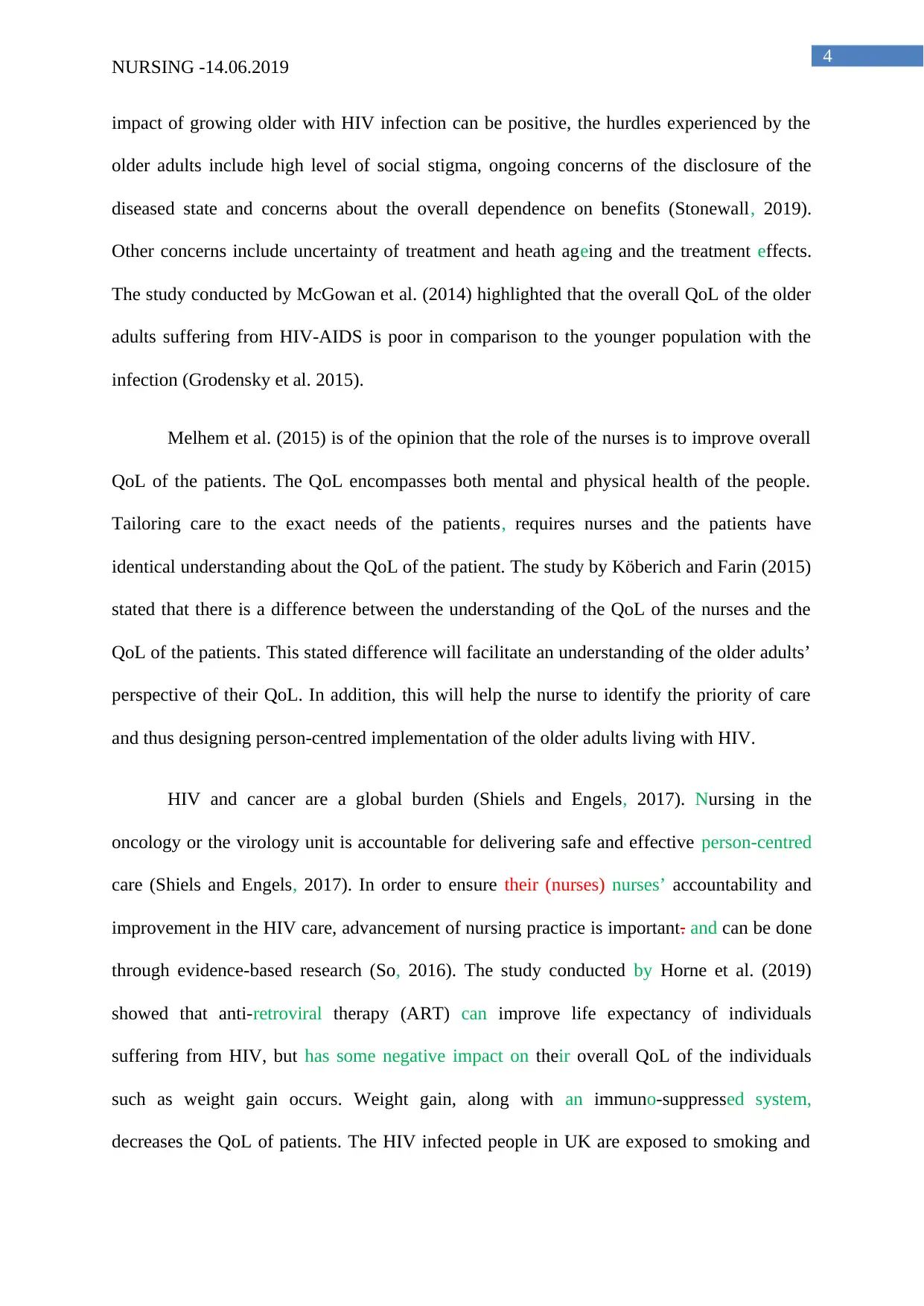
4
NURSING -14.06.2019
impact of growing older with HIV infection can be positive, the hurdles experienced by the
older adults include high level of social stigma, ongoing concerns of the disclosure of the
diseased state and concerns about the overall dependence on benefits (Stonewall, 2019).
Other concerns include uncertainty of treatment and heath ageing and the treatment effects.
The study conducted by McGowan et al. (2014) highlighted that the overall QoL of the older
adults suffering from HIV-AIDS is poor in comparison to the younger population with the
infection (Grodensky et al. 2015).
Melhem et al. (2015) is of the opinion that the role of the nurses is to improve overall
QoL of the patients. The QoL encompasses both mental and physical health of the people.
Tailoring care to the exact needs of the patients, requires nurses and the patients have
identical understanding about the QoL of the patient. The study by Köberich and Farin (2015)
stated that there is a difference between the understanding of the QoL of the nurses and the
QoL of the patients. This stated difference will facilitate an understanding of the older adults’
perspective of their QoL. In addition, this will help the nurse to identify the priority of care
and thus designing person-centred implementation of the older adults living with HIV.
HIV and cancer are a global burden (Shiels and Engels, 2017). Nursing in the
oncology or the virology unit is accountable for delivering safe and effective person-centred
care (Shiels and Engels, 2017). In order to ensure their (nurses) nurses’ accountability and
improvement in the HIV care, advancement of nursing practice is important. and can be done
through evidence-based research (So, 2016). The study conducted by Horne et al. (2019)
showed that anti-retroviral therapy (ART) can improve life expectancy of individuals
suffering from HIV, but has some negative impact on their overall QoL of the individuals
such as weight gain occurs. Weight gain, along with an immuno-suppressed system,
decreases the QoL of patients. The HIV infected people in UK are exposed to smoking and
NURSING -14.06.2019
impact of growing older with HIV infection can be positive, the hurdles experienced by the
older adults include high level of social stigma, ongoing concerns of the disclosure of the
diseased state and concerns about the overall dependence on benefits (Stonewall, 2019).
Other concerns include uncertainty of treatment and heath ageing and the treatment effects.
The study conducted by McGowan et al. (2014) highlighted that the overall QoL of the older
adults suffering from HIV-AIDS is poor in comparison to the younger population with the
infection (Grodensky et al. 2015).
Melhem et al. (2015) is of the opinion that the role of the nurses is to improve overall
QoL of the patients. The QoL encompasses both mental and physical health of the people.
Tailoring care to the exact needs of the patients, requires nurses and the patients have
identical understanding about the QoL of the patient. The study by Köberich and Farin (2015)
stated that there is a difference between the understanding of the QoL of the nurses and the
QoL of the patients. This stated difference will facilitate an understanding of the older adults’
perspective of their QoL. In addition, this will help the nurse to identify the priority of care
and thus designing person-centred implementation of the older adults living with HIV.
HIV and cancer are a global burden (Shiels and Engels, 2017). Nursing in the
oncology or the virology unit is accountable for delivering safe and effective person-centred
care (Shiels and Engels, 2017). In order to ensure their (nurses) nurses’ accountability and
improvement in the HIV care, advancement of nursing practice is important. and can be done
through evidence-based research (So, 2016). The study conducted by Horne et al. (2019)
showed that anti-retroviral therapy (ART) can improve life expectancy of individuals
suffering from HIV, but has some negative impact on their overall QoL of the individuals
such as weight gain occurs. Weight gain, along with an immuno-suppressed system,
decreases the QoL of patients. The HIV infected people in UK are exposed to smoking and

5
NURSING -14.06.2019
drinking which further decreases their QoL. Moreover, HIV patients are more vulnerable
towards developing cancer and cardiovascular complications (So 2016). However, majority
of the factors that decrease the QoL of the older adults with HIV are obtained from the
perspective of the physicians and from the basis of physiological parameters. No study has
been conducted to study the perspective of the survivors (Jeffries et al. 2017). Analysis of the
study by Catalan et al. (2017) will help to understand the sociological or the mental health
concerns of the people with HIV. Understanding perspective of PLHIV will help to design
evidence-based practice guidelines and interventions in adult nursing.
Section two
Whenever a study is conducted in nursing research, there are three possible
explanations behind the generation of the result. First, are the findings true; second do the
findings represent random variations; and thirdly, are the findings influenced by systematic
error (bias). Random error includes deviation from the truth and thus representing false
positive results (Grove, Gray and Faan, 2019). The systematic distortion of the estimated
interventions hampers the overall validation of evidence-based practice. Numerous studies
have been conducted to show that bias can obscure at least 60% of the quality of intervention
in healthcare (Grove, Gray and Faan 2019). A mounting body of evidences has stated that
biased results generated from the poorly designed studies mislead the overall process of
decision making in all level of healthcare (Grove, Gray and Faan, 2019). Thus, critical
appraisal of the articles is important in order to judge the methodological quality of the
research and to estimate the level of risks or degree of bias associated with the study. This
helps to judge the reliability, validity and trustworthiness of the research. A reliable, valid
and trustworthy research with credible findings helps to increase the value of the results. The
NURSING -14.06.2019
drinking which further decreases their QoL. Moreover, HIV patients are more vulnerable
towards developing cancer and cardiovascular complications (So 2016). However, majority
of the factors that decrease the QoL of the older adults with HIV are obtained from the
perspective of the physicians and from the basis of physiological parameters. No study has
been conducted to study the perspective of the survivors (Jeffries et al. 2017). Analysis of the
study by Catalan et al. (2017) will help to understand the sociological or the mental health
concerns of the people with HIV. Understanding perspective of PLHIV will help to design
evidence-based practice guidelines and interventions in adult nursing.
Section two
Whenever a study is conducted in nursing research, there are three possible
explanations behind the generation of the result. First, are the findings true; second do the
findings represent random variations; and thirdly, are the findings influenced by systematic
error (bias). Random error includes deviation from the truth and thus representing false
positive results (Grove, Gray and Faan, 2019). The systematic distortion of the estimated
interventions hampers the overall validation of evidence-based practice. Numerous studies
have been conducted to show that bias can obscure at least 60% of the quality of intervention
in healthcare (Grove, Gray and Faan 2019). A mounting body of evidences has stated that
biased results generated from the poorly designed studies mislead the overall process of
decision making in all level of healthcare (Grove, Gray and Faan, 2019). Thus, critical
appraisal of the articles is important in order to judge the methodological quality of the
research and to estimate the level of risks or degree of bias associated with the study. This
helps to judge the reliability, validity and trustworthiness of the research. A reliable, valid
and trustworthy research with credible findings helps to increase the value of the results. The
⊘ This is a preview!⊘
Do you want full access?
Subscribe today to unlock all pages.

Trusted by 1+ million students worldwide
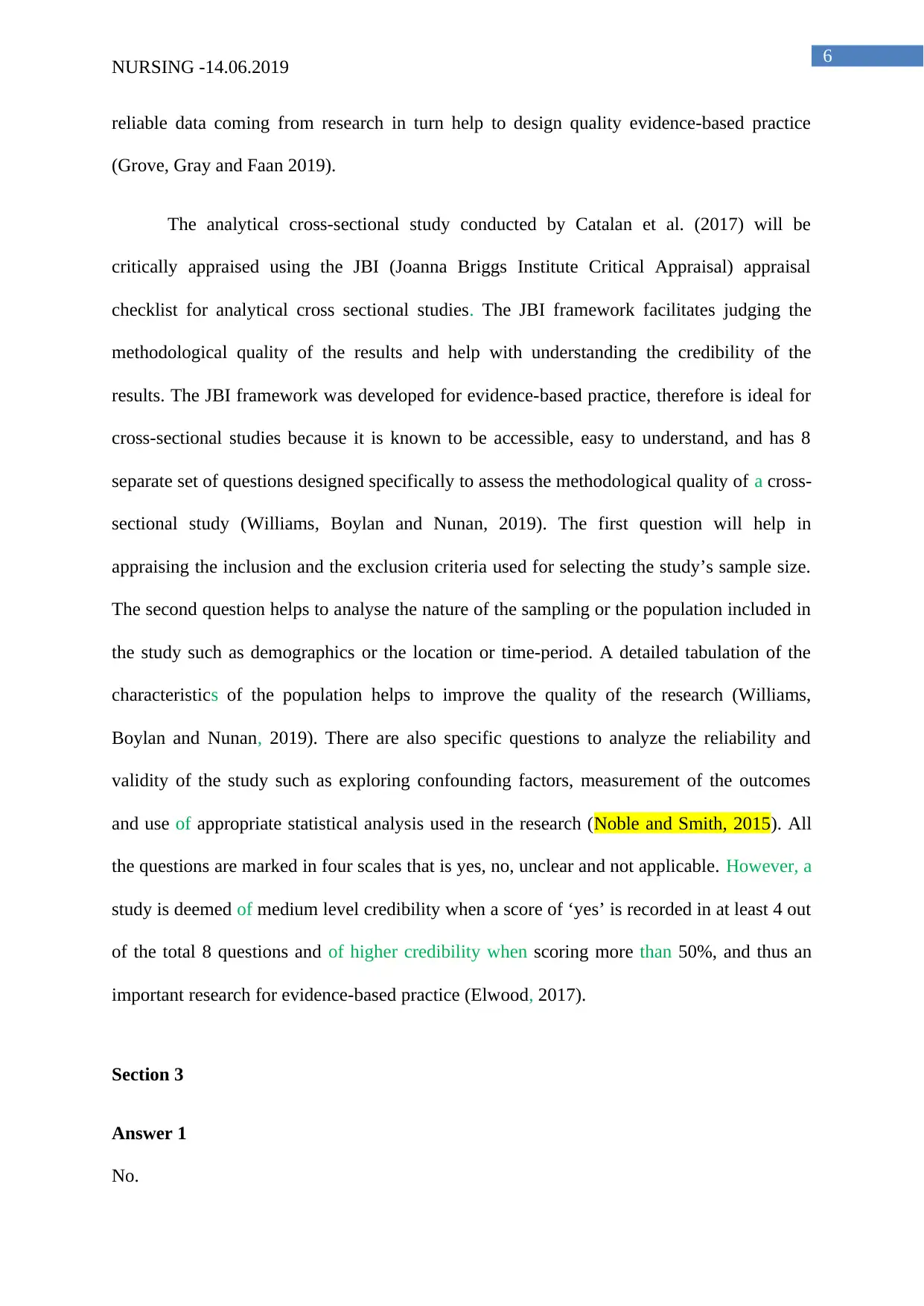
6
NURSING -14.06.2019
reliable data coming from research in turn help to design quality evidence-based practice
(Grove, Gray and Faan 2019).
The analytical cross-sectional study conducted by Catalan et al. (2017) will be
critically appraised using the JBI (Joanna Briggs Institute Critical Appraisal) appraisal
checklist for analytical cross sectional studies. The JBI framework facilitates judging the
methodological quality of the results and help with understanding the credibility of the
results. The JBI framework was developed for evidence-based practice, therefore is ideal for
cross-sectional studies because it is known to be accessible, easy to understand, and has 8
separate set of questions designed specifically to assess the methodological quality of a cross-
sectional study (Williams, Boylan and Nunan, 2019). The first question will help in
appraising the inclusion and the exclusion criteria used for selecting the study’s sample size.
The second question helps to analyse the nature of the sampling or the population included in
the study such as demographics or the location or time-period. A detailed tabulation of the
characteristics of the population helps to improve the quality of the research (Williams,
Boylan and Nunan, 2019). There are also specific questions to analyze the reliability and
validity of the study such as exploring confounding factors, measurement of the outcomes
and use of appropriate statistical analysis used in the research (Noble and Smith, 2015). All
the questions are marked in four scales that is yes, no, unclear and not applicable. However, a
study is deemed of medium level credibility when a score of ‘yes’ is recorded in at least 4 out
of the total 8 questions and of higher credibility when scoring more than 50%, and thus an
important research for evidence-based practice (Elwood, 2017).
Section 3
Answer 1
No.
NURSING -14.06.2019
reliable data coming from research in turn help to design quality evidence-based practice
(Grove, Gray and Faan 2019).
The analytical cross-sectional study conducted by Catalan et al. (2017) will be
critically appraised using the JBI (Joanna Briggs Institute Critical Appraisal) appraisal
checklist for analytical cross sectional studies. The JBI framework facilitates judging the
methodological quality of the results and help with understanding the credibility of the
results. The JBI framework was developed for evidence-based practice, therefore is ideal for
cross-sectional studies because it is known to be accessible, easy to understand, and has 8
separate set of questions designed specifically to assess the methodological quality of a cross-
sectional study (Williams, Boylan and Nunan, 2019). The first question will help in
appraising the inclusion and the exclusion criteria used for selecting the study’s sample size.
The second question helps to analyse the nature of the sampling or the population included in
the study such as demographics or the location or time-period. A detailed tabulation of the
characteristics of the population helps to improve the quality of the research (Williams,
Boylan and Nunan, 2019). There are also specific questions to analyze the reliability and
validity of the study such as exploring confounding factors, measurement of the outcomes
and use of appropriate statistical analysis used in the research (Noble and Smith, 2015). All
the questions are marked in four scales that is yes, no, unclear and not applicable. However, a
study is deemed of medium level credibility when a score of ‘yes’ is recorded in at least 4 out
of the total 8 questions and of higher credibility when scoring more than 50%, and thus an
important research for evidence-based practice (Elwood, 2017).
Section 3
Answer 1
No.
Paraphrase This Document
Need a fresh take? Get an instant paraphrase of this document with our AI Paraphraser
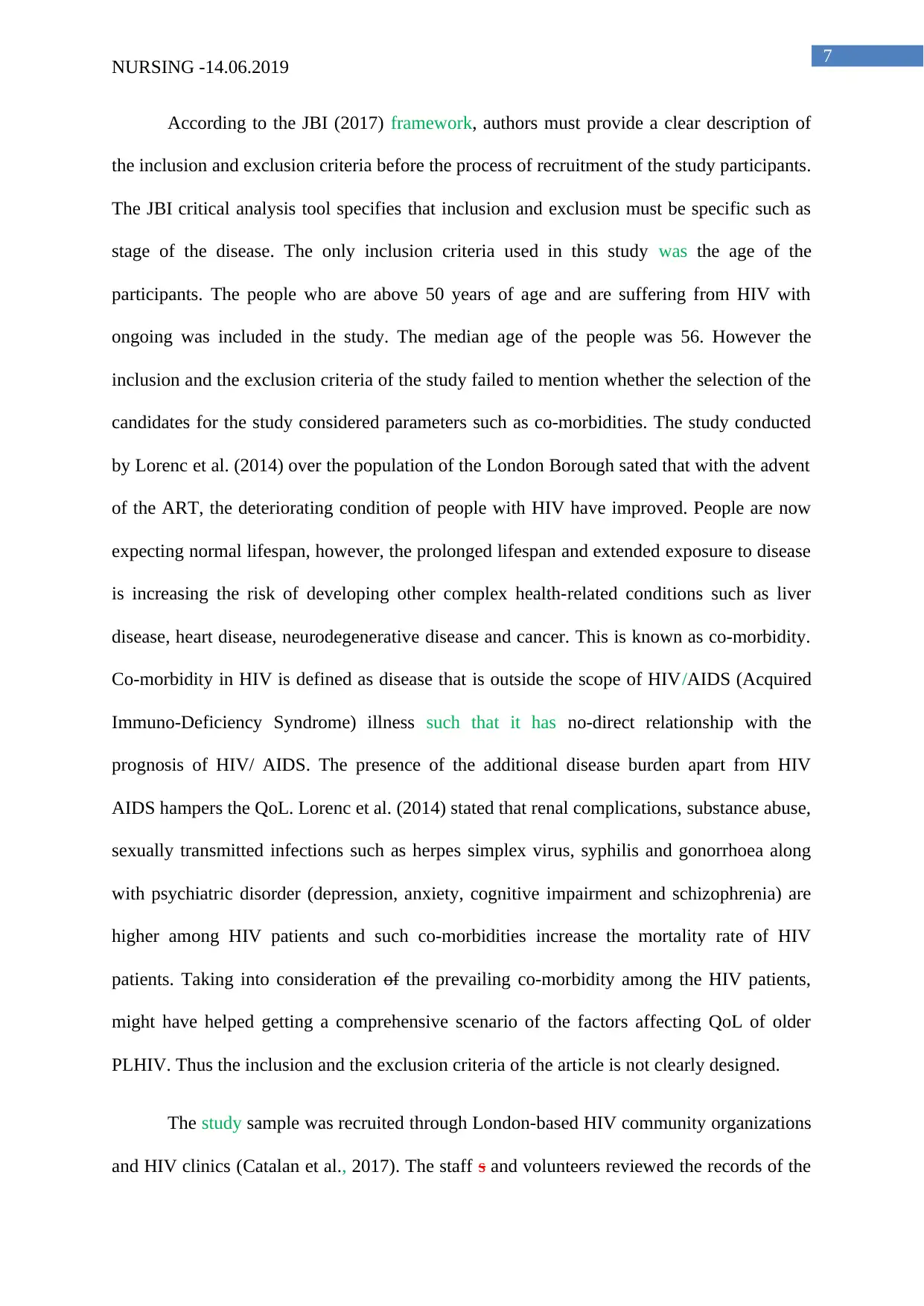
7
NURSING -14.06.2019
According to the JBI (2017) framework, authors must provide a clear description of
the inclusion and exclusion criteria before the process of recruitment of the study participants.
The JBI critical analysis tool specifies that inclusion and exclusion must be specific such as
stage of the disease. The only inclusion criteria used in this study was the age of the
participants. The people who are above 50 years of age and are suffering from HIV with
ongoing was included in the study. The median age of the people was 56. However the
inclusion and the exclusion criteria of the study failed to mention whether the selection of the
candidates for the study considered parameters such as co-morbidities. The study conducted
by Lorenc et al. (2014) over the population of the London Borough sated that with the advent
of the ART, the deteriorating condition of people with HIV have improved. People are now
expecting normal lifespan, however, the prolonged lifespan and extended exposure to disease
is increasing the risk of developing other complex health-related conditions such as liver
disease, heart disease, neurodegenerative disease and cancer. This is known as co-morbidity.
Co-morbidity in HIV is defined as disease that is outside the scope of HIV/AIDS (Acquired
Immuno-Deficiency Syndrome) illness such that it has no-direct relationship with the
prognosis of HIV/ AIDS. The presence of the additional disease burden apart from HIV
AIDS hampers the QoL. Lorenc et al. (2014) stated that renal complications, substance abuse,
sexually transmitted infections such as herpes simplex virus, syphilis and gonorrhoea along
with psychiatric disorder (depression, anxiety, cognitive impairment and schizophrenia) are
higher among HIV patients and such co-morbidities increase the mortality rate of HIV
patients. Taking into consideration of the prevailing co-morbidity among the HIV patients,
might have helped getting a comprehensive scenario of the factors affecting QoL of older
PLHIV. Thus the inclusion and the exclusion criteria of the article is not clearly designed.
The study sample was recruited through London-based HIV community organizations
and HIV clinics (Catalan et al., 2017). The staff s and volunteers reviewed the records of the
NURSING -14.06.2019
According to the JBI (2017) framework, authors must provide a clear description of
the inclusion and exclusion criteria before the process of recruitment of the study participants.
The JBI critical analysis tool specifies that inclusion and exclusion must be specific such as
stage of the disease. The only inclusion criteria used in this study was the age of the
participants. The people who are above 50 years of age and are suffering from HIV with
ongoing was included in the study. The median age of the people was 56. However the
inclusion and the exclusion criteria of the study failed to mention whether the selection of the
candidates for the study considered parameters such as co-morbidities. The study conducted
by Lorenc et al. (2014) over the population of the London Borough sated that with the advent
of the ART, the deteriorating condition of people with HIV have improved. People are now
expecting normal lifespan, however, the prolonged lifespan and extended exposure to disease
is increasing the risk of developing other complex health-related conditions such as liver
disease, heart disease, neurodegenerative disease and cancer. This is known as co-morbidity.
Co-morbidity in HIV is defined as disease that is outside the scope of HIV/AIDS (Acquired
Immuno-Deficiency Syndrome) illness such that it has no-direct relationship with the
prognosis of HIV/ AIDS. The presence of the additional disease burden apart from HIV
AIDS hampers the QoL. Lorenc et al. (2014) stated that renal complications, substance abuse,
sexually transmitted infections such as herpes simplex virus, syphilis and gonorrhoea along
with psychiatric disorder (depression, anxiety, cognitive impairment and schizophrenia) are
higher among HIV patients and such co-morbidities increase the mortality rate of HIV
patients. Taking into consideration of the prevailing co-morbidity among the HIV patients,
might have helped getting a comprehensive scenario of the factors affecting QoL of older
PLHIV. Thus the inclusion and the exclusion criteria of the article is not clearly designed.
The study sample was recruited through London-based HIV community organizations
and HIV clinics (Catalan et al., 2017). The staff s and volunteers reviewed the records of the

8
NURSING -14.06.2019
patients in order to identify who satisfied the study’s inclusion criteria, that is, having been
diagnosed with HIV for at least 12 months and not suffering from any acute psychological
symptoms. However, the development of the psychological symptoms can occur within one
week or during the course of an entire month (Haynes, Smith and Hunsley 2018). A detailed
psychological status of an individual can be obtained only by having a psychological
assessment of the patient through mental health professionals like by the use of the mental
health assessment tool (DSM V) [Diagnostic and Statistical Manual of Mental Disorders].
Thus the study’s inclusion criteria is flawed. Furthermore, the study failed to specify which
HIV clinics it considered for the recruitment of the population. Choosing London-based HIV
community organizations for the selection of the main population in the study can be
regarded as selection bias (Certo et al., 2016). Selection of the HIV patients from London
leads to the selection of patients only from the city who have more healthcare access unlike
the people living in rural areas. However, this leads to bias analysis of the factors associated
with HRQoL (Wilson et al., 2017). Selection bias can be minimised by using rigorous criteria
in order to avoid confounding bias results. A well-designed study might help to avoid
selection bias at the time of enrolment (Althubaiti, 2016).
Answer 2
Yes.
The JBI critical analysis tool (2017) for an analytical cross-sectional study, state that
the authors must have a clear description about the population that is recruited in the study
such as proper description of the demographic details, location of the population along with
the time period. The description of participant selection mainly focused on the description of
the participants such as their characteristics, their sexual orientation and age (Catalan et al,
2017). The study included a total of 100 PLHIV who were over 50 years of age and
consisting of 73 men and 27 women. Among them, 76 completed interviews and 24 were on-
NURSING -14.06.2019
patients in order to identify who satisfied the study’s inclusion criteria, that is, having been
diagnosed with HIV for at least 12 months and not suffering from any acute psychological
symptoms. However, the development of the psychological symptoms can occur within one
week or during the course of an entire month (Haynes, Smith and Hunsley 2018). A detailed
psychological status of an individual can be obtained only by having a psychological
assessment of the patient through mental health professionals like by the use of the mental
health assessment tool (DSM V) [Diagnostic and Statistical Manual of Mental Disorders].
Thus the study’s inclusion criteria is flawed. Furthermore, the study failed to specify which
HIV clinics it considered for the recruitment of the population. Choosing London-based HIV
community organizations for the selection of the main population in the study can be
regarded as selection bias (Certo et al., 2016). Selection of the HIV patients from London
leads to the selection of patients only from the city who have more healthcare access unlike
the people living in rural areas. However, this leads to bias analysis of the factors associated
with HRQoL (Wilson et al., 2017). Selection bias can be minimised by using rigorous criteria
in order to avoid confounding bias results. A well-designed study might help to avoid
selection bias at the time of enrolment (Althubaiti, 2016).
Answer 2
Yes.
The JBI critical analysis tool (2017) for an analytical cross-sectional study, state that
the authors must have a clear description about the population that is recruited in the study
such as proper description of the demographic details, location of the population along with
the time period. The description of participant selection mainly focused on the description of
the participants such as their characteristics, their sexual orientation and age (Catalan et al,
2017). The study included a total of 100 PLHIV who were over 50 years of age and
consisting of 73 men and 27 women. Among them, 76 completed interviews and 24 were on-
⊘ This is a preview!⊘
Do you want full access?
Subscribe today to unlock all pages.

Trusted by 1+ million students worldwide

9
NURSING -14.06.2019
line participants who completed self-administered questionnaires. Catalan et al. (2017) also
sub-divided the population based on ethnicity of the included population, such that 57 were
White British, 13 White other, 28 Black African, and 2 were Black other. Of the total selected
population, 51 were men who had sex with men (MSM) and 45 heterosexual and 4 bisexual.
The maximum age limit was 87 years and 56 as median age.
The description of the sexual orientation was important because HIV is a sexually
transmitted disease. According to NHS England (2019), a high rate of HIV is reported in gay
men in the UK. During the year 2015, 101,000 people in the UK were reported living with
HIV. The selection of participants is mainly dominated by MSM. This is beneficial for
designing targeted interventions to improve QoL for the bisexuals and homosexual (men)
(Wilson et al. 2016).
The demographics presented in the study by Catalan et al. (2017) described ethnicity
of the selected population. The sample recruited population from different ethnicity which
helps to avoid the chances of selection bias. However, the authors did not highlight the exact
location or the residence of the population during the recruitment process. This can be
regarded as one of the limitation of the study. Wilson et al. (2017) are of the opinion that the
HIV infected people who reside in the rural or the remote areas become victims of
stigmatization and social exclusion along with poor access to healthcare services in order to
which hinders managing the associated health complications arising from HIV. These barriers
hamper the overall QoL. Lack of specification of the residence of the recruited sample
restricted the comprehensive analysis of the factors that influence HRQoL of the PLHIV.
Answer 3
No.
NURSING -14.06.2019
line participants who completed self-administered questionnaires. Catalan et al. (2017) also
sub-divided the population based on ethnicity of the included population, such that 57 were
White British, 13 White other, 28 Black African, and 2 were Black other. Of the total selected
population, 51 were men who had sex with men (MSM) and 45 heterosexual and 4 bisexual.
The maximum age limit was 87 years and 56 as median age.
The description of the sexual orientation was important because HIV is a sexually
transmitted disease. According to NHS England (2019), a high rate of HIV is reported in gay
men in the UK. During the year 2015, 101,000 people in the UK were reported living with
HIV. The selection of participants is mainly dominated by MSM. This is beneficial for
designing targeted interventions to improve QoL for the bisexuals and homosexual (men)
(Wilson et al. 2016).
The demographics presented in the study by Catalan et al. (2017) described ethnicity
of the selected population. The sample recruited population from different ethnicity which
helps to avoid the chances of selection bias. However, the authors did not highlight the exact
location or the residence of the population during the recruitment process. This can be
regarded as one of the limitation of the study. Wilson et al. (2017) are of the opinion that the
HIV infected people who reside in the rural or the remote areas become victims of
stigmatization and social exclusion along with poor access to healthcare services in order to
which hinders managing the associated health complications arising from HIV. These barriers
hamper the overall QoL. Lack of specification of the residence of the recruited sample
restricted the comprehensive analysis of the factors that influence HRQoL of the PLHIV.
Answer 3
No.
Paraphrase This Document
Need a fresh take? Get an instant paraphrase of this document with our AI Paraphraser
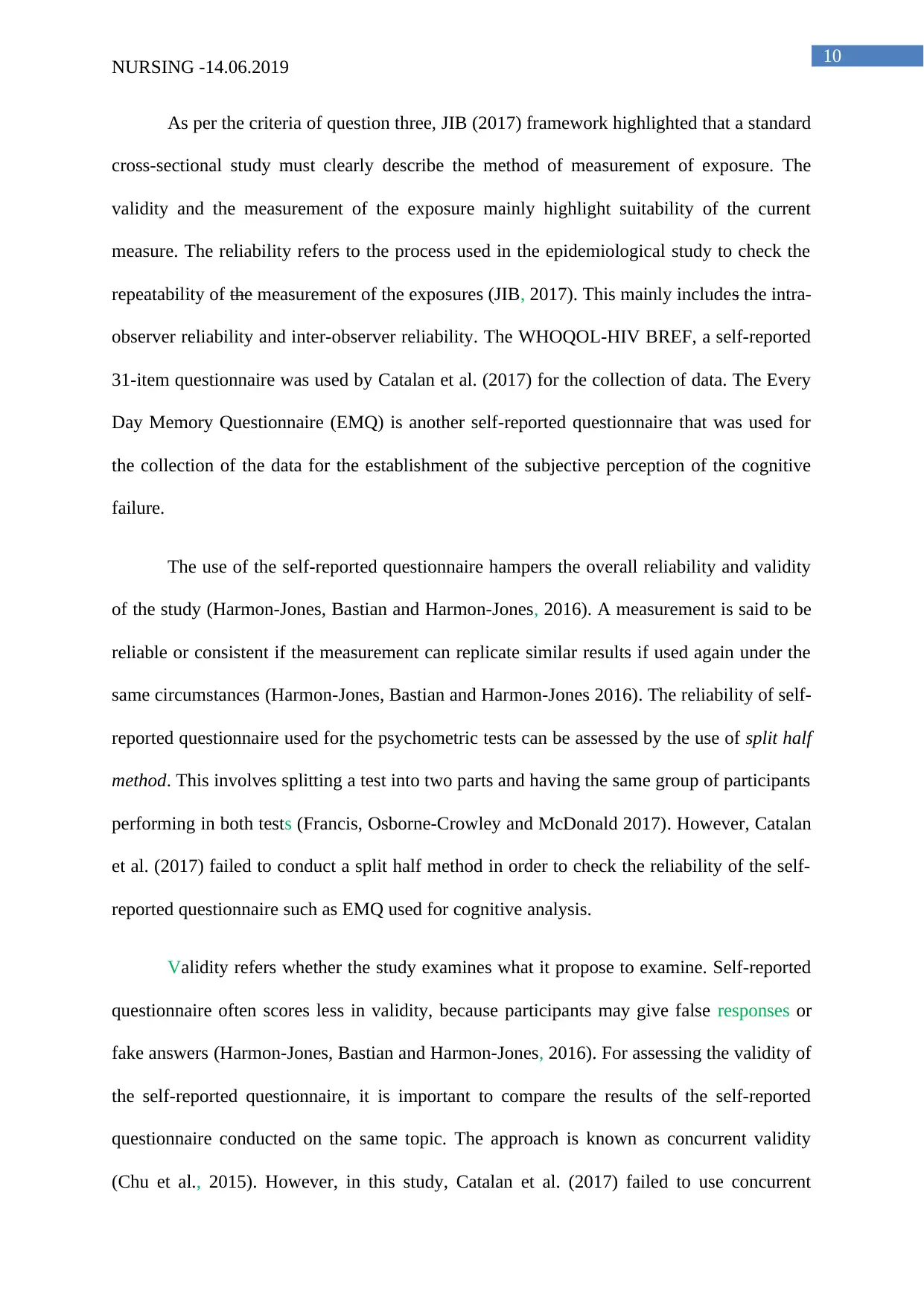
10
NURSING -14.06.2019
As per the criteria of question three, JIB (2017) framework highlighted that a standard
cross-sectional study must clearly describe the method of measurement of exposure. The
validity and the measurement of the exposure mainly highlight suitability of the current
measure. The reliability refers to the process used in the epidemiological study to check the
repeatability of the measurement of the exposures (JIB, 2017). This mainly includes the intra-
observer reliability and inter-observer reliability. The WHOQOL-HIV BREF, a self-reported
31-item questionnaire was used by Catalan et al. (2017) for the collection of data. The Every
Day Memory Questionnaire (EMQ) is another self-reported questionnaire that was used for
the collection of the data for the establishment of the subjective perception of the cognitive
failure.
The use of the self-reported questionnaire hampers the overall reliability and validity
of the study (Harmon-Jones, Bastian and Harmon-Jones, 2016). A measurement is said to be
reliable or consistent if the measurement can replicate similar results if used again under the
same circumstances (Harmon-Jones, Bastian and Harmon-Jones 2016). The reliability of self-
reported questionnaire used for the psychometric tests can be assessed by the use of split half
method. This involves splitting a test into two parts and having the same group of participants
performing in both tests (Francis, Osborne-Crowley and McDonald 2017). However, Catalan
et al. (2017) failed to conduct a split half method in order to check the reliability of the self-
reported questionnaire such as EMQ used for cognitive analysis.
Validity refers whether the study examines what it propose to examine. Self-reported
questionnaire often scores less in validity, because participants may give false responses or
fake answers (Harmon-Jones, Bastian and Harmon-Jones, 2016). For assessing the validity of
the self-reported questionnaire, it is important to compare the results of the self-reported
questionnaire conducted on the same topic. The approach is known as concurrent validity
(Chu et al., 2015). However, in this study, Catalan et al. (2017) failed to use concurrent
NURSING -14.06.2019
As per the criteria of question three, JIB (2017) framework highlighted that a standard
cross-sectional study must clearly describe the method of measurement of exposure. The
validity and the measurement of the exposure mainly highlight suitability of the current
measure. The reliability refers to the process used in the epidemiological study to check the
repeatability of the measurement of the exposures (JIB, 2017). This mainly includes the intra-
observer reliability and inter-observer reliability. The WHOQOL-HIV BREF, a self-reported
31-item questionnaire was used by Catalan et al. (2017) for the collection of data. The Every
Day Memory Questionnaire (EMQ) is another self-reported questionnaire that was used for
the collection of the data for the establishment of the subjective perception of the cognitive
failure.
The use of the self-reported questionnaire hampers the overall reliability and validity
of the study (Harmon-Jones, Bastian and Harmon-Jones, 2016). A measurement is said to be
reliable or consistent if the measurement can replicate similar results if used again under the
same circumstances (Harmon-Jones, Bastian and Harmon-Jones 2016). The reliability of self-
reported questionnaire used for the psychometric tests can be assessed by the use of split half
method. This involves splitting a test into two parts and having the same group of participants
performing in both tests (Francis, Osborne-Crowley and McDonald 2017). However, Catalan
et al. (2017) failed to conduct a split half method in order to check the reliability of the self-
reported questionnaire such as EMQ used for cognitive analysis.
Validity refers whether the study examines what it propose to examine. Self-reported
questionnaire often scores less in validity, because participants may give false responses or
fake answers (Harmon-Jones, Bastian and Harmon-Jones, 2016). For assessing the validity of
the self-reported questionnaire, it is important to compare the results of the self-reported
questionnaire conducted on the same topic. The approach is known as concurrent validity
(Chu et al., 2015). However, in this study, Catalan et al. (2017) failed to use concurrent
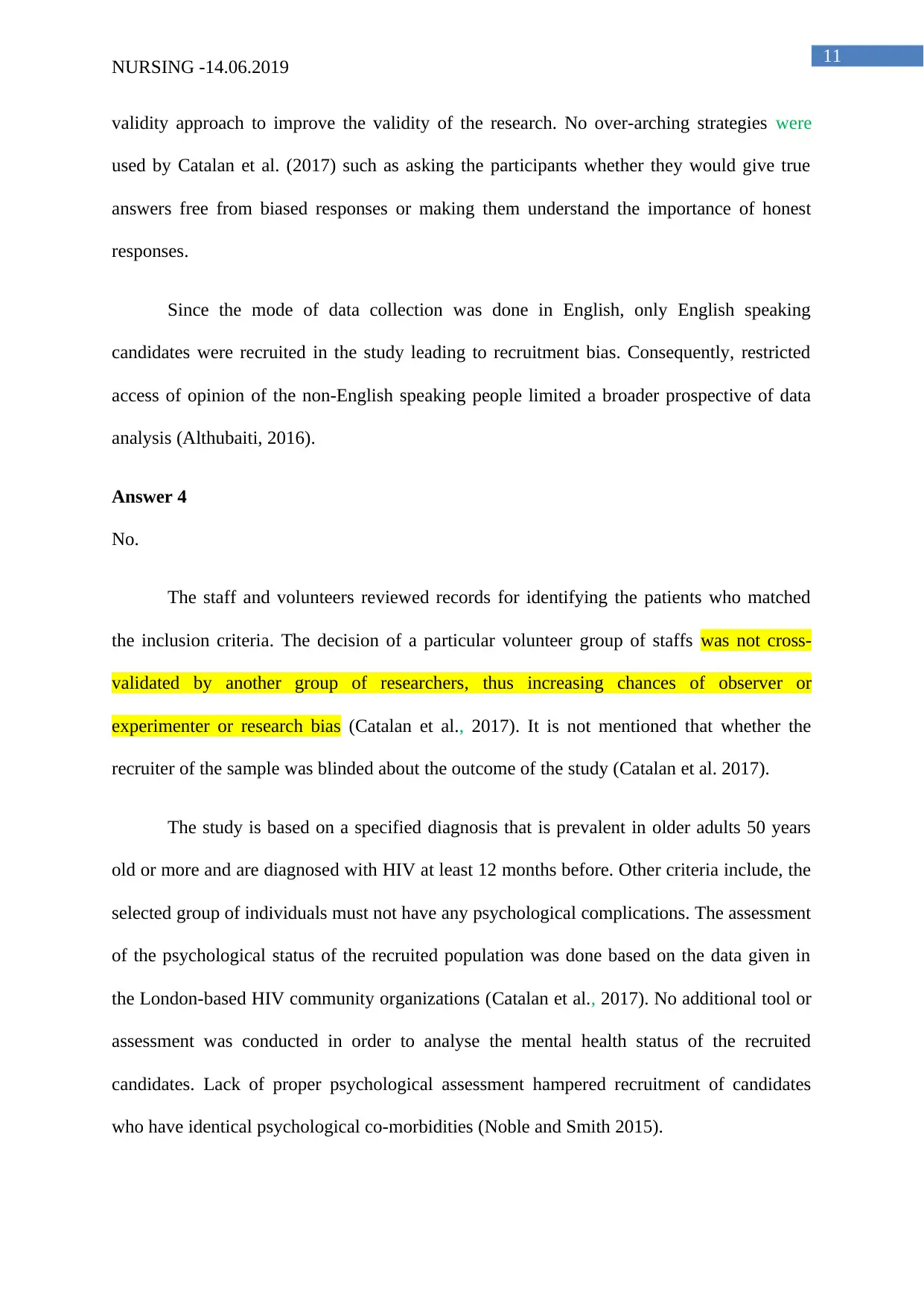
11
NURSING -14.06.2019
validity approach to improve the validity of the research. No over-arching strategies were
used by Catalan et al. (2017) such as asking the participants whether they would give true
answers free from biased responses or making them understand the importance of honest
responses.
Since the mode of data collection was done in English, only English speaking
candidates were recruited in the study leading to recruitment bias. Consequently, restricted
access of opinion of the non-English speaking people limited a broader prospective of data
analysis (Althubaiti, 2016).
Answer 4
No.
The staff and volunteers reviewed records for identifying the patients who matched
the inclusion criteria. The decision of a particular volunteer group of staffs was not cross-
validated by another group of researchers, thus increasing chances of observer or
experimenter or research bias (Catalan et al., 2017). It is not mentioned that whether the
recruiter of the sample was blinded about the outcome of the study (Catalan et al. 2017).
The study is based on a specified diagnosis that is prevalent in older adults 50 years
old or more and are diagnosed with HIV at least 12 months before. Other criteria include, the
selected group of individuals must not have any psychological complications. The assessment
of the psychological status of the recruited population was done based on the data given in
the London-based HIV community organizations (Catalan et al., 2017). No additional tool or
assessment was conducted in order to analyse the mental health status of the recruited
candidates. Lack of proper psychological assessment hampered recruitment of candidates
who have identical psychological co-morbidities (Noble and Smith 2015).
NURSING -14.06.2019
validity approach to improve the validity of the research. No over-arching strategies were
used by Catalan et al. (2017) such as asking the participants whether they would give true
answers free from biased responses or making them understand the importance of honest
responses.
Since the mode of data collection was done in English, only English speaking
candidates were recruited in the study leading to recruitment bias. Consequently, restricted
access of opinion of the non-English speaking people limited a broader prospective of data
analysis (Althubaiti, 2016).
Answer 4
No.
The staff and volunteers reviewed records for identifying the patients who matched
the inclusion criteria. The decision of a particular volunteer group of staffs was not cross-
validated by another group of researchers, thus increasing chances of observer or
experimenter or research bias (Catalan et al., 2017). It is not mentioned that whether the
recruiter of the sample was blinded about the outcome of the study (Catalan et al. 2017).
The study is based on a specified diagnosis that is prevalent in older adults 50 years
old or more and are diagnosed with HIV at least 12 months before. Other criteria include, the
selected group of individuals must not have any psychological complications. The assessment
of the psychological status of the recruited population was done based on the data given in
the London-based HIV community organizations (Catalan et al., 2017). No additional tool or
assessment was conducted in order to analyse the mental health status of the recruited
candidates. Lack of proper psychological assessment hampered recruitment of candidates
who have identical psychological co-morbidities (Noble and Smith 2015).
⊘ This is a preview!⊘
Do you want full access?
Subscribe today to unlock all pages.

Trusted by 1+ million students worldwide
1 out of 27
Related Documents
Your All-in-One AI-Powered Toolkit for Academic Success.
+13062052269
info@desklib.com
Available 24*7 on WhatsApp / Email
![[object Object]](/_next/static/media/star-bottom.7253800d.svg)
Unlock your academic potential
Copyright © 2020–2025 A2Z Services. All Rights Reserved. Developed and managed by ZUCOL.





